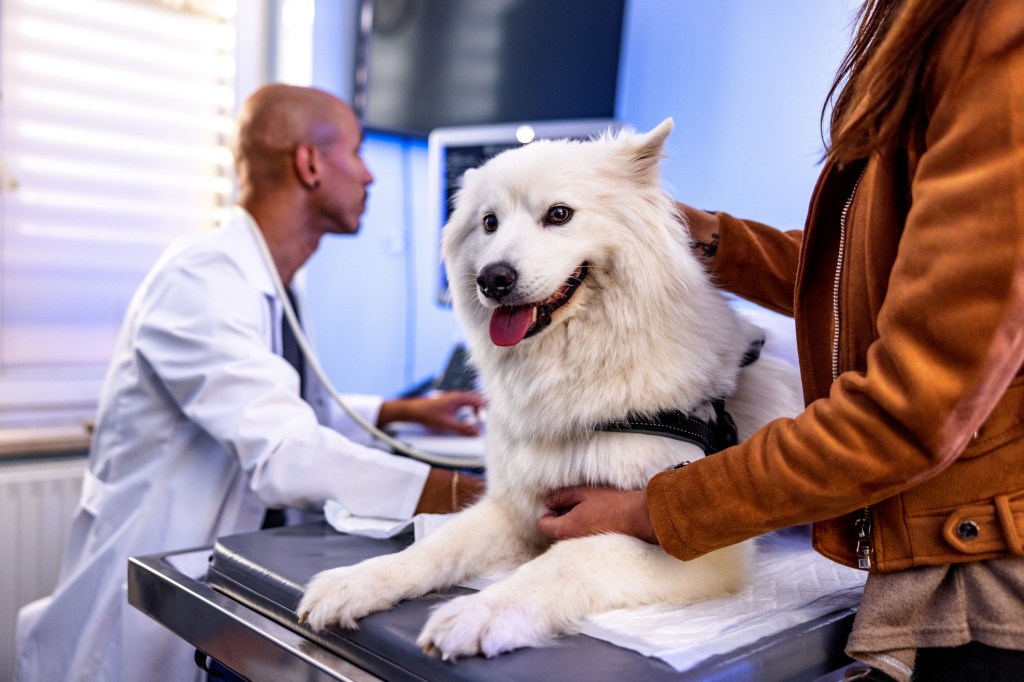Amoxicillin is an FDA-approved broad-spectrum antibiotic commonly prescribed to treat bacterial infections in dogs. It is derived from penicillin and can effectively inhibit the growth of bacteria by preventing the bacteria from building a proper protective cell wall. Given its efficacy and relatively safe profile, amoxicillin has become a go-to prescription for many veterinarians. Amoxicillin for dogs is available under several brand names, including Amoxil, Amoxi-Tabs, Amoxi-Drop, Bimox, Moxatag, and Novamoxin.
Here’s what you should know about amoxicillin’s uses, dosage, and side effects for dogs.
Uses of amoxicillin for dogs
Amoxicillin is primarily used to treat bacterial infections in dogs. These may include:
- Skin infections
- Urinary tract infections (UTI)
- Respiratory infections
- Gastrointestinal infections
- Bite wound infections
- Soft tissue infections
- Bone infections
- Lyme disease
- Leptospirosis
The drug’s effectiveness against both gram-positive and gram-negative bacteria makes it a valuable tool in combating infectious diseases in dogs. Additionally, vets may prescribe amoxicillin to tackle dental infections and as a preventative measure in certain surgical procedures to avoid potential infections from occurring. It’s essential to follow your veterinarian’s guidance when using amoxicillin, as its effectiveness is dependent on the type of bacteria present and the location of the infection.
Dosage of amoxicillin for dogs

The following is a guideline for the typical use of the drug in dogs and must not replace your veterinarian’s advice for your individual pet.
The dosage of amoxicillin for dogs typically depends on several factors, including your dog’s weight, the severity of the infection, and the type of infection. The duration of treatment can vary. It’s important to note that you must complete the full course of amoxicillin as prescribed by your vet, even if your dog seems to recover before finishing the medication. This helps to avoid relapse or antibiotic resistance.
Amoxicillin is given by mouth and comes in various forms, including tablets, capsules, and a liquid suspension. The choice of form will depend on your dog’s preferences and your veterinarian’s recommendations. You can administer the medication with or without food. However, if vomiting occurs on an empty stomach, give subsequent doses with food. If you are giving your pet liquid amoxicillin, make sure to shake it well before use.
Your vet may prescribe amoxicillin either as a standalone treatment or in combination with other antibiotics to enhance its efficacy. A prominent example is Clavamox — a veterinary antibiotic that combines amoxicillin with clavulanic acid. The addition of clavulanic acid boosts the effectiveness of amoxicillin, enabling Clavamox to tackle a broader spectrum of infections.
Remember to store amoxicillin tablets and capsules in a cool, dry place, away from direct sunlight, maintaining a controlled room temperature of 59–86°F. Moreover, avoid keeping the dried powder at temperatures exceeding 77°F. Liquid amoxicillin suspension is best kept in the refrigerator and should be discarded after 14 days.
Side effects of amoxicillin for dogs
While amoxicillin is generally safe for dogs, some may experience side effects. These include:
- Vomiting
- Diarrhea
- Stomach pain
- Loss of appetite
- Allergic reactions
In rare cases, more serious effects can occur — such as seizures or excessive tiredness. If you observe any of these side effects, contact your vet immediately.
It’s also worth noting that dogs with a known allergy to penicillin or penicillin-type drugs should not be given amoxicillin. In addition, if your dog is currently on any medication, there might be potential interactions with amoxicillin. Specifically, you should exercise caution when it comes to:
- Bacteriostatic antimicrobials — a different class of antibiotics
- Methotrexate — immunosuppressive medication used for cancer treatment
- Probenecid — to manage uric acid stones and gout
- Warfarin — blood thinner
Generally, amoxicillin is deemed safe for dogs who are pregnant or nursing. Nevertheless, it’s crucial to keep a close eye on your pet and adhere strictly to the guidance provided by your veterinarian. As such, always inform your vet about all medications — including over-the-counter supplements — your dog is currently taking to avoid adverse drug interactions.
If you miss giving a dose of amoxicillin to your dog, administer the missed dose as soon as you remember. However, if the time is close to their next scheduled dose, it’s best to skip the missed dose and continue with their regular medication routine. Do not give your pet a double dose of amoxicillin.









